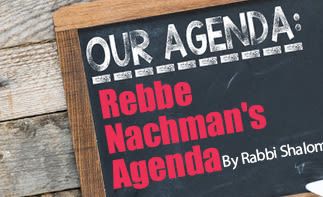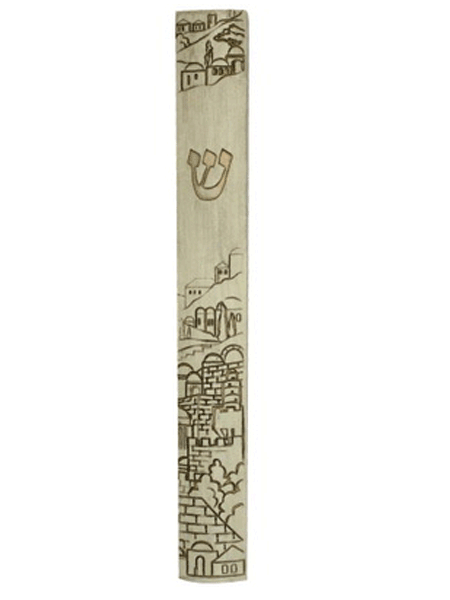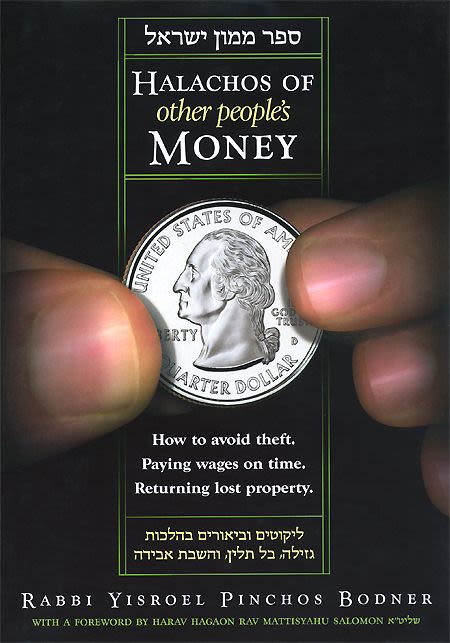
Breslev Customs for Elul
Breslev Chassidut has a number of customs for the month of Elul.

Most Breslever Chassidim in Eretz Yisrael recite the prayers of Yom Kippur Katan every Erev Rosh Chodesh. But even those who do not observe Yom Kippur Katan every month recite the prayers on Erev Rosh Chodesh Elul and Erev Rosh Chodesh Nisan. In addition, many Breslever Chassidim travel to Meron on Erev Rosh Chodesh Elul to recite the Yom Kippur Katan prayers beside the grave of the holy Tanna, Rabbi Shimon Bar Yochai.
* * *
Rebbe Nachman encouraged his followers to recite the Tikkunei Zohar as well as additional prayers and supplications during the month of Elul. It is also customary to remain in the synagogue and Beit Medrash to learn Torah later than usual at night. Rebbe Nachman said, “The niggun with which the Tikkunei Zohar is recited, and the strain and fatigue produced by staying late in the Beis Medrash, are all made into great and lofty things on high” (Sichos haRan 294).
* * *
Reb Nosson praises the custom of reading the entire TaNaKH during the days of Elul and Tishrei, finishing on Hoshanah Rabbah (See Otzar haYirah, Teshuvas haShanah, Elul).
* * *
However, not everyone can do this. Once, while recovering from surgery, Rabbi Elazar Kenig mentioned that he hoped to complete the Rebbe’s Sippurei Ma’asiyos before Rosh Hashanah. This is an example of how we must adjust our goals to our abilities and circumstances at every stage of life, and how more modest avodahs are also meaningful.
* * *
Breslever Chassidim recite Psalm 27 (LeDovid HaShem Ori) immediately after Tachanun, or after Shemoneh Esreh when there is no Tachanun, prior to Kaddish. This seems to have been a regional custom, which is also observed by the Chassidim of Chernobyl/Skver. (As to the source of this minhag in general, Mateh Ephraim cites Midrash Shocher Tov, 27, that “ori[my light]” alludes to Rosh Hashanah, “yishi [my salvation]” alludes to Yom Kippur, and “ki yitzpineni bisukkah [For He will hide me in His shelter]” alludes to Sukkot. However, the minhag of reciting Psalm 27 daily during these weeks seems to have originated during the late 17th century; see Rabbi Nochum Greenwald, “Yachsam shel Gedolei haChassidus le Sefer Chemdas Yamim,” Kovetz Heichal haBaal Shem Tov, vol. II, 2 [Brooklyn, NY 2004], p. 56. Rabbi Greenwald cites Rabbi Borukh Katz that Sefer Shem Tov haKatan [Salzburg 1705] by Rabbi Binyamin Beinish Hakohen seems to be to be the earliest written source for this minhag.)
* * *
Reb Noson darshans on the common custom to sound the shofar every day at the end of Shacharit from Rosh Chodesh Elul until Erev Rosh Hashanah (See Likkutei Halakhos, Birkhas haRe’ah 5:18).
* * *
It is customary to recite additional Tehillim during Elul and the Ten Days of Repentance. (Likkutei Moharan II, 73. According to the mesorah of Chabad/Lubavitch, this also was the custom of the Baal Shem Tov, who would recite three chapters a day until Yom Kippur, when he would finish the rest of Tehillim; cf. Sefer Minhagim−Chabad, Elul, p. 54 ff. citing Kovetz Mikhtavim leTehillim, p. 207. Matteh Ephraim 581:8 cites the widespread custom of reciting ten chapters per day beginning on Rosh Chodesh Elul, so that one completes Sefer Tehillim twice before Rosh Hashanah, and one more time during the Aseres Yemei Teshuvah; similarly Rabbi Chaim Elazar Spira of Munkatch, Darkhei Chaim viShalom, Chodesh Elul, 687.)
Selichot
Selichot for Ashkenazim follow the Polish minhag. As the Shulchan Arukh stipulates, they are recited on the days prior to Rosh Hashanah, and throughout the Aseret Yemei Teshuvah until Erev Yom Kippur.
Sefardim begin reciting selichot immediately after Rosh Chodesh Elul.
(Shulchan Arukh, Orach Chaim 581:1. Reb Noson mentions this custom in Likkutei Halakhos, Devarim Haba’im beSeudah 4:3; Matanah 5:20)
* * *
In the passages that begin E-l Melekh yoshev… the nusach of the ARI zal is say u’mitnaheg bachassidut, adding the connecting letter vav, rather than “mitnaheg,” as in most printed texts. When asked about this custom, Rabbi Elazar Kenig replied, “It is not a difficult thing to do, and it does not require a kabbalistic kavanah [which might be beyond the ken of the average person] − so why not do it?” His answer reflects a general rule regarding the ARI zal’s customs. (See Rabbi Chaim Vital, Pri Etz Chaim, Sha’ar haSelichos 8, citing Zohar III, 228a, and Tikkunei Zohar, Hakdamah, 11c. Cf. Siddur ARI Rav Shabbsai; Likkutei MaHaRiCH III, p. 601; Sefer Minhagim−Chabad, et al.)
* * *
The ARI zal recited vidui only once during selichot (although he did not omit the paragraphs between the other two repetitions of vidui), while the more common minhag is to recite it three times. Rabbi Elazar Kenig remarked that most Breslevers probably follow the common minhag, adding “and for some of us, that’s still not enough!” He explained that each time we recite the vidui, we should do so with greater sincerity. (For the custom of the ARI, see Rabbi Chaim Vital, Pri Etz Chaim, Sha’ar haSelichot 8 [end]; similarly the GRA, cited in Sha’arei Rachamim; Rabbi Chaim Elazar Spira of Munkatch, Darkhei Chaim viShalom, Chodesh Elul, 703; Sefer Minhagim−Chabad, et al. Re. the threefold recitation of vidui, see Likkutei MaHaRiCH III, p. 602, citing the Baal haRokeach, Minhagim, and Levush; also see the Butchatcher Rov, Eishel Avraham, Orach Chaim 581.)
Khof Elul (20-Elul)
The twentieth of Elul is the Yahrtzeit of Rabbi Avraham Sternhartz (1862-1955), grandson of the Tcheriner Rav, great-grandson of Reb Noson, and teacher of numerous Breslever Gedolim. An orphan, Reb Avraham was raised by the Tcheriner Rov, and during his youth met all of the living talmidim of Reb Noson, including Reb Moshe Breslever. He was Baal Mussaf and Baal Tokei’a for many decades in Uman, and served as Rav of Kremenchug until he escaped the U.S.S.R. at the height of the Stalinist purges, arriving in Yerushalayim in 1936. Reb Avraham immediately became a key figure in the Yerushalayim community, attracting many talmidim, and soon established the Rosh Hashanah kibbutz in Meron. After his histalkut in 1955, his disciple, Rabbi Gedalia Kenig devoted himself to carrying on his revered teacher’s legacy.
In Eretz Yisrael, se’udot are held in Reb Avraham’s honor on the evening of Khof Elul. During the afternoon, many Breslever Chassidim travel to the Har Menuchot Cemetery in Yerushalayim to recite Tehillim and pray beside Reb Avraham’s kever. Outside of Israel, many Breslever Chassidim also light a candle, give tzedakah, share a se’udoh in his honor, and learn some of his teachings from Tovot Zichronot, etc.
for(After Reb Avraham passed away, Rabbi Gedaliah Kenig published his teacher’s Tovot Zichronot, Breslever teachings related to the first ten lessons in Likkutei Moharan, together with the Tcheriner Rov’s Yerach haEisanim, chiddushim on Likkutei Moharan related to Rosh Hashanah, and Reb Avraham’s Imrot Tehorot on the importance of traveling to tzaddikim, particularly Rabbi Nachman, for Rosh Hashanah. Some of Reb Avraham’s letters were published by Reb Noson Zvi Kenig of Bnei Brak as Rinat Tzion. A scholarly biography of Reb Avraham is being prepared for publication in the near future by Rabbi Nachman Burshteyn of Jerusalem.)











Tell us what you think!
Thank you for your comment!
It will be published after approval by the Editor.